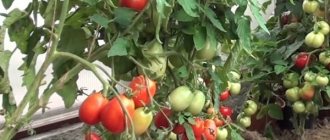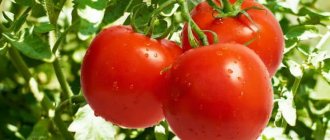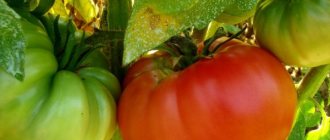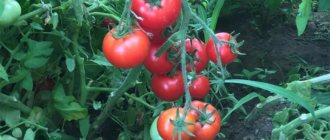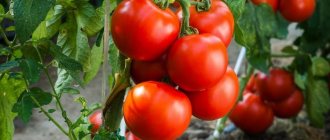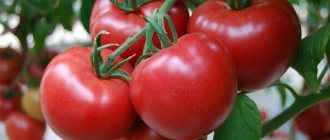Description of Casanova tomatoes
Now in nature there are a huge number of varieties that have nothing in common with the usual ideas about tomatoes. Interestingly, many people consider the tomato a vegetable. In fact, it is a berry from a botanical point of view.
It is not only the appearance of the fruit that has undergone changes. Tomatoes of hitherto unseen colors were bred: yellow, orange, brown, blue, and even almost black. There are even varieties of tomatoes that, when fully ripe, retain their green color, and this does not affect their taste at all. The Casanova tomato shown in the photo has only positive reviews from those who planted this variety. The Casanova tomato was developed relatively recently, in 2015. The originator is V. N. Dederko. It is approved for cultivation in all regions of Russia. The Casanova tomato entered the state register of breeding achievements in 2021. Its scope of application is garden plots and personal plots.
The Casanova tomato variety, reviews of which can be found below, belongs to the mid-season, indeterminate and high-yielding varieties of tomatoes. The height of the Casanova tomato variety can reach 1.8-2 m. The first tomatoes appear in mid-July if the seedlings are planted in early to mid-March. Since the Casanova variety belongs to the tall variety and does not stop growing on its own, the bush is formed manually.
The stem of the Casanova tomato variety is strong, the number of leaves on it is average. The plant has a superbly developed root system.
The leaves of the Casanova variety are medium in size, green in color and have a rough and bumpy surface. Inflorescences are complex.
The marketable yield of Casanova tomatoes is 10.8 kg/1 m². The highest yield can be achieved by forming plants with 1 or 2 stems. It is also necessary to comply with all agrotechnical rules.
Interesting fact!
The Casanova tomato variety was created by agro breeders.
The fruits form simple clusters. The degree of foliage of the bush is average. The plant requires tying to a support and pinching. Judging by the reviews of summer residents, Casanova tomatoes (see photo) can be grown in open ground and in a greenhouse. Growing in greenhouse conditions is possible in any region of Russia. Tomatoes are grown in open ground only in the southern regions.
Disembarkation and care
Tomatoes are planted in a greenhouse earlier than in open ground, since the soil in it warms up faster. Sometimes this is possible as early as the beginning of May. The beds for planting must be prepared in the fall, and the greenhouse itself and the soil must be disinfected. In the fall, phosphorus and potassium fertilizers are applied at 30 g per square meter. m, and in the spring - nitrogen - 15 g for the same area. If you do not open the greenhouse for the winter, all fertilizers can be applied in the fall.
Attention! When tomatoes are grown every year, the soil in a greenhouse is quickly depleted and pathogens accumulate in it.
Experienced gardeners advise changing the top layer of soil at least as much as a spade every 3 years.
From organic fertilizers you need to add humus - up to 8 kg per square meter. m or 300 g of vermicompost for the same area. Ash can be a good source of potassium, especially if the soil reaction is acidic. It also contains microelements. The source of calcium is crushed eggshells. On sandy loam soils there is a deficiency of magnesium. It can be replenished by applying Mag-bor fertilizer, which will simultaneously enrich the soil with boron.
Warning! Many gardeners apply fertilizer only locally - in the planting holes, without caring about the rest of the soil.
But this is only starting food. In the future, the roots of the tomatoes will occupy the entire area of the bed, and they will not have enough food.
Casanova tomato seedlings are planted in prepared and watered holes. Planting pattern: 40 cm between bushes and 60 cm between rows. Overgrown Casanova tomato seedlings are planted in grooves, removing the lower leaves with the top oriented to the north.
Plantings must be mulched with straw or mowed grass, which must first be dried. Last year's hay will also work. The next watering can be done in about a week. But if plants signal a lack of moisture by wilting leaves, it needs to be done earlier.
What else do Casanova tomatoes need for a good harvest:
- Timely watering. There is no rain in the greenhouse, so the lack of moisture will be on the conscience of the gardener. The soil moisture level is maintained at about 80%, and the air at about 50%. This is achieved by weekly watering at the root. Pour enough water to wet the ground by 50 cm. It is better to water early in the morning, but the water must be warm. Casanova tomatoes will appreciate drip irrigation. In this case, the supply of moisture to plants will be optimal.
- Tomato Casanova responds very well to feeding. They are carried out every ten days, starting 12 days after rooting of seedlings. The best choice is special fertilizers designed for feeding nightshade crops.
- To ensure that the Casanova tomato spends all its energy on forming a crop, and not on growing stepsons, they are regularly torn off, leaving a stump of 1 cm. For the Casanova tomato, the best form of cultivation is in 2 stems.
For more information on the rules for growing tomatoes in a greenhouse, watch the video:
If all the rules for planting and growing are observed, Casanova tomatoes will respond to the gardener with a generous harvest of original and tasty fruits. This amazing embodiment of the imagination of breeders will delight not only you, but also your guests.
Characteristics of Casanova tomatoes
Casanova tomatoes have a cylindrical shape and can reach a length of 18-20 cm. The density is average, the fruits are slightly ribbed. Unripe tomatoes are colored in light green shades, while fully ripe ones are traditionally red. The number of seed nests does not exceed 2-3. The weight of the fruit is from 150 to 200 g. The skin and pulp of this variety are dense, with a small number of seeds.
Casanova tomatoes have excellent taste characteristics. They are not prone to cracking, are well stored and can be easily transported. They can be consumed fresh, for cutting salads and used in home canning. When canned, tomatoes retain their shape. It is not recommended to subject them to heat treatment entirely. It is better to cut the fruits into halves or prepare lecho, ketchup or tomato juice from them.
"Pros and cons"
Despite its relatively young age, the Casanova tomato variety has already managed to take a strong place in the seed market and find its admirers, who love it for the following advantages:
- unpretentiousness in cultivation;
- possibility of growing in a greenhouse and open ground;
- high productivity;
- atypical shape of tomatoes;
- outstanding taste characteristics;
- high commercial qualities;
- good transportability;
- a wide range of uses in all kinds of dishes.
The disadvantages of the Casanova tomato variety include the following:
- bushes need constant tying up and removal of stepsons;
- The Casanova tomato variety has reduced immunity to most diseases and pests.
However, the positive qualities of the tomato easily compensate for its minor shortcomings.
Procedures for planting seedlings
The Casanova tomato variety is very demanding in maintenance. To obtain an excellent harvest, it is necessary to follow the established rules when planting. First you need to prepare the seedlings. A complete selection of only healthy and high-quality seeds is necessary. After making the selections, they should be soaked.
To do this, take a napkin soaked in water, or you can use a cloth, and lay out the seeds on it. They are left in this form for a day. If suddenly seeds begin to germinate on the fabric, then they should be planted in well-moistened soil. If fresh seeds are used, then this action can be missed.
See also
Description of the Qingdao tomato variety, its yield and cultivationRead
IMPORTANT: To plant tomatoes, you should use soil consisting of a mixture of turf soil and humus. It would be useful to add sawdust and peat.
March is considered the optimal time of year for planting seedlings. First you need to prepare special containers (maybe an ordinary box) approximately 10 centimeters deep. Next, plant the seeds to a depth of 1 centimeter. Then the container is covered. For this you can use plastic or regular film.
Rules you should know for successful seedling cultivation:
- Light. Good lighting should be provided around the clock, as this variety requires a lot of light.
- Temperature. During seed germination, it should be from 23 to 25 °C. For grown and strengthened seeds, the temperature can reach from 16 to 20 °C.
- Watering. This procedure should be done once every 5-7 days. These tomatoes do not need frequent watering. Watering can be done if the soil is dry. The water temperature should be room temperature.
- It should be remembered that there should be no drafts in the room where the seedlings are located.
If the seedlings suddenly turn yellow, the reason for this could be an excess of water or a lack of light. Next, wait until the seeds germinate. Picking is carried out when the first leaves appear on the stems. A glass with a volume of 0.5 liters is suitable for this. You should not take a smaller volume, otherwise you will have to replant the seedlings again.
Proper cultivation of Casanova tomato
To obtain seedlings, Casanova tomato seeds are planted 2-2.5 months before transplanting to a permanent location. This usually occurs in early to mid-March.
Sowing seeds for seedlings consists of the following steps:
- It is necessary to treat the seeds with preparations to disinfect and stimulate growth. Usually a solution of potassium permanganate or peroxide is used. Zircon will help activate the germination process.
- Before sowing, the soil is slightly moistened and the plant containers are disinfected.
- Casanova tomato seeds are planted in rows at intervals of several centimeters. This promotes uniform distribution of light, which is very important for young shoots.
- Cover the seeds with a thin layer of soil, no more than 0.5-1 cm.
- Containers with seeds are transferred to a warm place with a good level of light. To retain heat and humidity, the top of the container should be covered with glass or polyethylene.
- As soon as the first shoots hatch, the container should be moved to a cooler place. A window sill can be such a place, you just need to pay attention to the degree of illumination.
Features of growing the variety
The process of growing Casanova tomatoes begins with the preparation of seedlings.
Two months before planting in open ground (approximately mid-March), seeds are sown. Work algorithm:
- Large seeds are selected for seedlings.
- Before planting, the material is treated with disinfectants and growth stimulants. The optimal antibacterial drugs are hydrogen peroxide, aloe juice and manganese solution.
- To awaken the seeds, melt water (pre-frozen rain or river) is used. The unfrozen liquid is drained, and the remaining is heated to room temperature and the seed is placed. Melt water retains its beneficial properties for 12 hours.
- Before sowing, the soil is frozen and then moistened.
- Containers for seedlings are disinfected with boiling water or a manganese solution.
- The seeds are sown in the ground, maintaining a distance of several centimeters between them.
- Containers with material are placed in a warm, well-lit room. The top of the container is covered with plastic wrap.
When the first shoots appear, the containers are moved to a place with a lower temperature.
Attention! To obtain seedlings you need good lighting. Seedlings require temperatures in the range from +18 to +22 °C. After the top layer of soil has dried, water it, avoiding waterlogging.
When 2 true leaves appear on each seedling, they proceed to diving. They are transplanted into containers of larger volume (from 0.5 liters and above)
After the top layer of soil has dried, water it, avoiding waterlogging. When 2 true leaves appear on each seedling, they proceed to diving. They are transplanted into containers of larger volume (from 0.5 liters and above)
Seedlings require temperatures in the range from +18 to +22 °C. After the top layer of soil has dried, water it, avoiding waterlogging. When 2 true leaves appear on each seedling, they proceed to diving. They are transplanted into containers of larger volume (from 0.5 liters and above).
Casanova tomatoes need feeding. It is carried out in several stages. After the third leaf appears, nitrogen fertilizer is used. The next fertilizing is applied 14–15 days after planting in the ground. After another 2 weeks, feed the plant with complex fertilizer.
They begin hardening a few weeks before planting in open ground or a greenhouse. At first, the Casanova tomato requires protection from the sun and wind from a covering material.
You can plant tomatoes in a greenhouse in early May. Casanova seedlings should be moved to open ground conditions only after stable weather has established, when night frosts do not pose a threat. This occurs at the end of May or beginning of June. The method of planting varies depending on the terrain, site and other factors. When planting in a greenhouse, adhere to the following recommendations:
- A greenhouse for tomatoes must be prepared in the fall. The beds are being dug up. Carry out comprehensive disinfection.
- Potassium-phosphorus fertilizers are applied to the soil. If fertilizing is applied in the spring, you should choose preparations with a predominance of nitrogen.
- Plants can be replanted only after the temperature in the greenhouse rises to +20 °C.
The temperature should be identical when planting in an open area. Schemes for planting in the ground or in a greenhouse:
- Prepare the wells by pouring 1 liter of water into each.
- Add peat mixture or humus.
- A distance of at least 40 cm must be maintained between holes.
Tomato Casanova needs good watering. If tomatoes are grown in greenhouse conditions (where there is no natural precipitation), air humidity should exceed 50%. Tomatoes in a greenhouse need to be watered daily. Water is applied under the roots. In the morning, moisten the soil with warm water.
Important! Loosening is carried out after the soil is moistened. Ash and mineral complexes are considered the optimal feeding. Ash and mineral complexes are considered the optimal feeding
Ash and mineral complexes are considered the optimal feeding.
To increase the fruiting of Casanova tomatoes, it is recommended to use boric acid
To treat tomatoes, dilute 2 grams of the drug per 10 liters of water.
The Casanova tomato variety needs pinching. The bushes are freed from young shoots located in the axils of the leaves.
Pests and diseases
According to gardeners, the Casanova tomato is susceptible to many diseases. The most common ones are:
- late blight or brown rot. For treatment, garlic infusion or the drugs “Barrier” and “Barrier” are used.
- brown spot. To combat it, the drug “Hom” is used.
- fusarium wilt. The Barrier remedy is suitable for the treatment of this disease.
- top rot. A mixture of honey and limestone, which is used to feed plants, helps to get rid of it.
In addition to diseases that are dangerous for the Casanova tomato, various pests can destroy it.
- slugs You can drive them away from tomatoes using slaked lime. To do this, you need to treat the ground next to the bushes with the prepared solution. Then you need to loosen it well and sprinkle with ground black pepper.
- bear The drug “Grom” has proven itself well in the fight against this pest.
- wireworm The “Bazudin” remedy will help get rid of it.
- spider mite A solution of karbofos helps a lot.
To protect plants from pests, tomatoes need regular inspection. Chemical treatment begins at the first appearance of signs of disease or pests.
You can learn how the Casanova tomato grows and bears fruit from the video review
Collection and storage of tomatoes
There are several diseases that can affect tomatoes. To treat late blight or brown rot, use the drugs “Barrier”, “Barrier” or garlic tincture. To combat brown spot, you can use the drug “Hom.” To treat fusarium wilt, you should use “Barrier.” To eliminate blossom end rot, you need to fertilize with honey or lime.
If the plant is attacked by pests, then you can fight them in the following ways:
- Slugs can be exterminated if the soil in the root area is sprinkled with slaked lime, then loosened and sprinkled with hot pepper.
- The drug “Thunder” will save you from mole crickets.
- The drug “Bazudin” will help exterminate the wireworm.
- Spider mites will be removed by the drug "Karbofos".
Casanova, like any other tomato, is subject to diseases typical for the species:
- Late blight. Appears in the form of gray and brown spots throughout the bush. For treatment, “Oxyx” and “Zaslon” are used. Spraying with garlic tincture gives good results.
- Cladosporiosis. Characterized by velvety spots on the leaves and at the bottom of the stem. It is treated with the drugs "Oxyx" and "Hom".
- Apex rot. Wet dark spots on green fruits are a signal of calcium deficiency. The crop needs to be fed with neutral lime or chalk.
- Furation wilt. First the foliage on the branch withers, and then the whole branch withers. It is necessary to spray the bush with “Barrier”.
- Fomoz. Due to excess water or fertilizer, rot spots appear on leaves, stems and fruits. In this case, Oksikhom will help.
Pests do not ignore this variety of tomatoes:
- Aphid. Capable of destroying large plantations if not stopped in time. In a garden, this can be done by washing the bushes with soapy water, sprinkling them with ash and spraying them with an infusion of onion peels and garlic. On an industrial scale, it is necessary to pollinate fields with insecticides.
- Spider mite. It weaves small webs on the lower parts of the leaves and sucks moisture from the plant. Karbofos is used for prevention and treatment.
- Slugs. They feast on leaves and can eat the entire bush. To prevent them from reaching the plant, slaked lime and finely chopped hot pepper are placed around the stem.
- Medvedka. Digs the ground near the plant, eating its roots. A vinegar solution or the drug “Thunder” is used against this large insect.
- Whitefly. These small pests attack tomato tops, causing them to wither, turn black and dry out. To save the seedlings, the plantation is sprayed with the Confidor insecticide.
Green and brown tomatoes ripen well and are stored in wooden boxes, lined with dry straw. Upon reaching the technical maturity of the fruits, the boxes are moved to a cool place, where the variety can be stored for another 1–2 months.
The Casanova tomato is interesting both in appearance and in its exceptional product characteristics. With proper, simple care, the crop can produce a large harvest of high-quality fruits with a long shelf life.
Reviews of Casanova tomato
Inna, Dnepropetrovsk. I really liked this variety. Productivity is high, pleasant taste, tomatoes without voids. We planted a little, just to try. Next year we plan to increase the number of bushes. It is easy to care for, like all varieties.
Alexander, Cherepovets I grow the Casanova variety in a greenhouse. I'm very pleased with the result. There are a lot of tomatoes ripening, so we have time to eat them fresh and pickle them for the winter. They are stored well in jars, they do not lose their shape or crack. And most importantly, you can collect the seeds and plant them next year.
Plant care
Casanova tomatoes require sufficient water during the growing period. After watering, it is necessary to loosen the soil. The bushes are very positive about feeding. You can use organic fertilizers, such as ash, or mineral fertilizers. It would be useful to treat with a solution of boric acid, approximately 1 gram per 5 liters of water. Do not forget about removing young shoots. They usually grow in the axils of leaves. This will help you get beautiful fruits in the future.
Transplanting to a garden bed
Transplantation into open ground is done 50-60 days after the seedlings are sown. Signs that seedlings are ready for transplanting are as follows:
- the presence of 1-2 flower brushes;
- The height of the seedling is about 30 centimeters, there are strong and thick stems, each of which has 5-7 leaves.
IMPORTANT: Seedlings of no more than 4 plants per 1 square meter are planted. It is necessary to prepare holes the size of the container in which the seedlings (cup) are located. Then the seedling is immersed in the hole and buried in it. Next you need to compact it a little and water it.
Good harvest with proper planting
According to the description, the period for growing seedlings from the moment of sowing the seeds until transplanting into the greenhouse is 50-60 days. This usually occurs in the first ten days of May.
In the southern zone, where tomatoes are grown in open ground, replanting is carried out only after the air temperature reaches 20°C and the soil warms up to 10-12°C.
The readiness of seedlings can be determined by the following signs:
- the presence of one or two flower brushes;
- seedlings are about 25 cm high, have 3-4 pairs of leaves.
To grow tomatoes in an open garden bed or in a greenhouse, the soil needs to be fertilized - 1 square meter. m. add 30 g of potassium salt and superphosphate.
For planting, holes are prepared according to the size of the planting container where the seedlings were grown. The holes are spilled with water, then the plants are replanted using the method of transferring an earthen clod.
After this, all the voids are covered with garden soil and the soil around the stems is compacted and watered with warm water at the rate of one liter of water per plant.
When planting seedlings, they usually first spill the hole with water, spending 0.5-1.0 liters, and after it is absorbed, the roots of the seedlings are immersed there. After this, the planted seedlings are covered with soil up to half the height of the stem to increase the surface area for the formation of additional roots.
Advantages and disadvantages
Casanova tomatoes have many features that positively distinguish the variety from its competitors:
- rich aroma and delicate sweetish taste of the fruit;
- original appearance of tomatoes with non-standard sizes and shapes;
- long-term preservation of presentation;
- excellent transportability;
- universal use in cooking and preservation.
Despite the advantages, Casanova tomatoes also have several disadvantages:
- cultivation in open ground is possible only in warm southern regions;
- it is necessary to constantly prun the bushes;
- Tomato growth in height must be stopped in time;
- During fruiting, plants should be secured to a reliable support.



